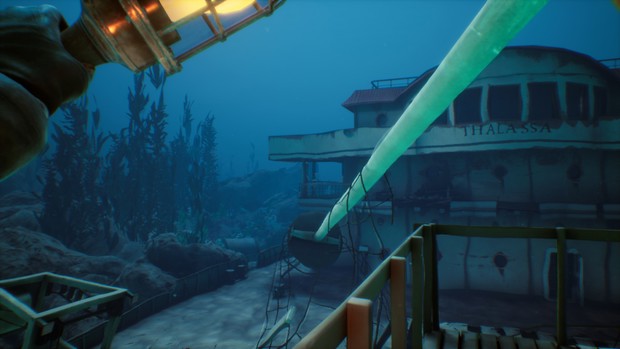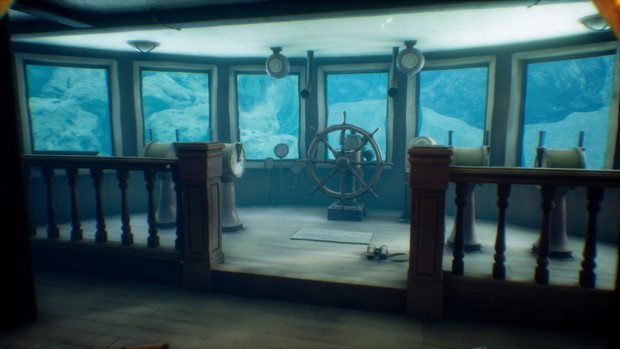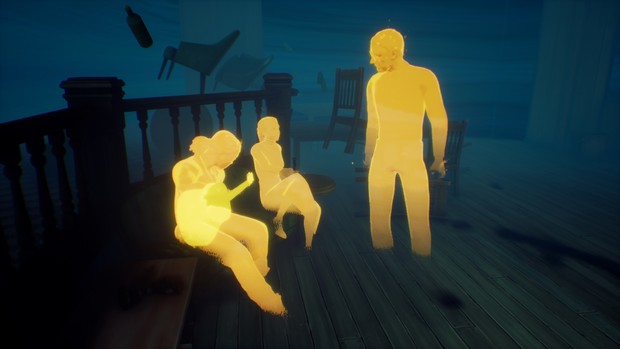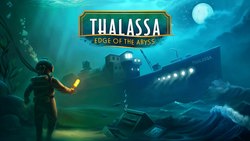Thalassa: Edge of the Abyss

- 0 Comments
A deeply compelling mystery emerges from this beautiful sunken-ship investigative mystery
I’m aquaphobic. Put me in a swimming pool and I’m as good as paralyzed as soon as the water level rises above my navel. So why in Poseidon’s name would I want to play a deep-sea diving game?! Because Thalassa: Edge of the Abyss is more than a diving game. It’s not even a realistic diving simulator. It’s an investigation game that just happens to take place underwater. And if you can keep an open mind, suspend your disbelief and follow the developer’s idea of reality mixed with fantasy, it’s a visually impressive story that offers plenty of fun and intriguing gameplay to uncover the many secrets aboard a shipwreck at the bottom of the ocean.
It’s the year 1905. You play as Cam, crew member of the S.S. Thalassa, a salvage ship on a mission to find the sunken Spanish galleon St. Catherine somewhere in the Antilles. Something goes wrong, however, and the Thalassa herself goes down while you are still on shore. Your mission suddenly changes from an archeological treasure hunt to having to find out why the ship sank and what happened to everybody on board.
Thalassa first astounds you with a Finding Nemo-style journey at the bottom of the Caribbean Sea. You walk around with a first-person viewpoint past colorful vegetation, impressive underwater cliffs, and little fish. It’s not a game that intends to scare you, so don’t expect a shark or giant octopus to suddenly jump out at you from a dark porthole. There are some tense moments, of course, like shuffling along an edge above an abyss, and a lifeboat suddenly dropping down from above. It’s all just to add excitement to the storytelling, however, since you can’t actually die, and there’s never a sequence that requires a do-over.

Roaming around the submerged ship is mesmerizing. Furniture, books and dozens of other items are floating everywhere. Fish occasionally swim by, though there aren’t many and you might go a fair while without noticing one. Your suit expels bubbles now and then, and you can see the water around you rippling, especially when you open a door and enter a new room. Everything has a blueish, greenish tint until you get close enough for Cam’s light, which turns everything more brown and golden. There’s only faint ambient music in a limited number of locations, like the accompanying tracks on an old Sounds of Nature CD, but the Thalassa is otherwise a silent place, with only your own heavy yet muffled footsteps, bubbling water and shifting objects creaking around you.
You’ll need to retrace your steps at times, because if you return to rooms you’ve already visited, it’s possible a cupboard will have opened up, perhaps with a new clue floating out. This is where that suspension of disbelief comes into play, designed to make the game more accessible. Cam’s suit doesn’t have a hose connected to the surface, nor any oxygen tanks that need checking and replacing at regular intervals. That lamp you’re carrying also seems to work on an infinite battery. This doesn’t make sense when you think about it, but it does give you the opportunity to engage in carefree exploration, and I accepted it as such. Same with the suddenly appearing new hotspots you didn’t notice earlier but Cam becomes aware of only after making the right deductions first.
Moving through the Thalassa isn’t all that realistic either. Once you enter the sunken ship, essentially the game doesn’t play much differently than investigation games in dryer settings, such as The Painscreek Killings. Cam doesn’t bob up and down as you would expect from someone hobbling along with weighted boots at the bottom of the sea, but the 3D camera moves fluidly as if it’s on rails. You have to scour the ship for clues in the form of preserved documents, diaries, letters, photos with messages written on the back, ledgers, notes, and even wax rolls on which voices are recorded. You are constantly confronted by obstacles like locked doors and debris blocking passageways. During the course of your journey you’ll find the tools and keys needed to open up all paths, but be prepared for some backtracking before those shortcuts become available.

Finding your way around the ship takes a good sense of direction, and I often took a wrong turn. Thankfully you can access a handy map that not only tells you where you are, but is constantly updated with color codes indicating the position of your current objective, and which rooms still hold secrets to find. The Thalassa is a big boat, with six different decks: the engine and boiler rooms way at the bottom, the crew cabins right above, the main deck with the great hall, galley and dining room, the officers’ deck with the fancier cabins, the garden deck with a little park where you would otherwise expect a swimming pool on a regular cruise ship, and finally the sun roof. Without the aid of the map, the game could have become very frustrating. What might easily have turned into a 30-hour search for needles in haystacks is instead a 10-hour adventure that flows smoothly along.
You can play Thalassa with a controller or WASD/mouse, and you can freely rebind should you choose the keyboard. I tried out both, and finally settled on a controller/mouse combo; controller for regular movement and interaction, the finer mouse precision for selecting items on the deduction board, which I’ll return to shortly. Hotspots are visibly indicated a short distance away by a golden compass rose icon. In the settings, you can choose to have them revealed from even further away, something I didn’t see the added value of personally.
Once close enough, the hotspot icon changes into an eye or a hand. Unfortunately, the game loses momentum every time you want to look at or pick up an object. The animation sometimes takes up to five seconds and three different camera adjustments to perfectly center your hotspot of interest until Cam’s arm finally reaches out for the object. This is really a problem and totally pulled me out of the game at first, though I did get used to it after a while. You don’t have an actual inventory you can use. Other than locating some tools and keys to bypass obstacles, which Cam will then automatically employ, there aren’t any true inventory puzzles.
Your quest is all about discovering as much information as you can, then connecting that info on a deduction board to reveal what actually happened. There are roughly 55 mysteries to unveil, and it’s simply a matter of filling in the blanks. For instance, at one point you find a note from a crew member about troubles on board, but without explanation other than that “the lady of the manor had to roll up her sleeves as well.” So you need to find out what exactly that person was talking about. Every such individual mystery will show a number of slots representing all the unknown factors, and you need to link them with the right evidence to reveal the whos, whats, hows and whys. These “riddles” aren’t that hard, but sometimes I had to switch the clues of two slots until I got it right. I had always chosen the right evidence, but apparently I just didn’t arrange them in that one perfect layout the game required.

Solving one mystery often leads to new questions, and the deduction board gets filled up pretty fast. When a chain of secrets has been successfully uncovered, you are rewarded with stylistic flashback scenes. Or rather, conceptual visualizations of how Cam believes they must have occurred. They show a shadow version of a room, with golden silhouettes of the characters, a bit like what you would see if looking at the scene through a thermal camera. But you can walk around in that scene, look at it from all angles as you listen to the characters talking, a bit like an interactive cutscene. Sometimes you might even spot an item one of them drops, so you can go look for it in the real world and use it to open up a previously blocked area.
There’s a full voice cast except for the silent main protagonist, Cam. I assume it’s an attempt to keep the character gender neutral, so each gamer can fully identify with them. The downside is that Cam’s diving assistant, who serves as a guide throughout the game, reacts to things you’ve apparently said which you as the player can’t hear or even read. This had a very weird effect on me, especially because of the gaps in dialogue, where the NPCs do seem to be listening to you. Dialogue options are lacking as well, so everything Cam might silently communicate comes automatically without any player choice.
The cast is great, however, and their voices fit their characters perfectly. Besides Bailey, your Scottish diving assistant who was also fortunate enough to be on shore when catastrophe struck, the former crew of the Thalassa hailed from all over the world. Isabel and her daughter Maria, who were behind the salvage of the St. Catherine, had Spanish roots that are very apparent in Isabel’s accent. Captain Hans was from Germany, while the expedition leader Erik was Norwegian. There was also Irish engineer Thomas, Jamaican mechanic Kaymar, Syrian chef Kadri, and Alex, your previous British diving partner, all perfectly sounding the part with the right accents and age range. The only issue I had was that the voice volume was rather on the low side. I had to adjust the settings, turning down all ambient sound and music while keeping the voices on full. But then later on, during some flashback scenes, the voice volume was suddenly cranked up all the way.
It’s this cast that makes the game. Uncovering the narrative behind the Thalassa’s demise is your main objective, after all, and it’s great to see all kinds of human, personal stories slowly develop even after death. Stories about love and jealousy, ambition and fear, pride and self-sacrifice. Each member of the crew had their own wants and needs, their own desires. Each had their reasons to act as they did, leading up to the tragedy of the ship. There’s a moral compass you can pin everything on, but you are sure to make the wrong assumptions if you haven’t collected all the facts. This game is full of surprises and succeeds in showing all aspects of its characters’ personalities. They’re a lovable bunch despite their darker sides, and even though the ship has sunk, while playing it really starts to feel like a new home.
Thalassa doesn’t allow manual saves, but it does record your progress automatically every time you change rooms. It even has 15 save slots, so it’s possible to reload a game from much earlier. When I finished the game and looked at the save files, I had saves going back 25 minutes, but of course this depends on how much time you spend in each room, and I was moving between the decks rather fast, having solved most mysteries and heading for the final revelations.
And those final revelations really kicked in. I was genuinely surprised by the way the story wrapped up in explaining what actually happened to the Thalassa. With all those different crew members, all with their own stories, attention keeps shifting between them in seeking out the one responsible for the disaster. During your investigation, you’ll uncover several dark secrets and can’t help but start making assumptions about whether or not the person involved could be the catalyst. Yet further research will seem to exonerate them, until only one explanation remains. And even though rationally I knew it’s all just a game, having spent so much time looking into these people’s lives, I couldn’t help but feel extremely sorry for them as victims of the ship’s demise.
Final Verdict
Thalassa: Edge of the Abyss tells many stories from beyond a watery grave. Walking around exploring the titular sunken vessel is an amazing experience. Finding all the clues to the ship’s tragedy satisfies that guilty pleasure of snooping through other people’s belongings, even if that feels a bit morbid knowing what happened to them. And uncovering the truth by means of the deduction board is very rewarding, if not particularly challenging. The wonky camera when closing in on hotspots, and the fickle volume of the voices are only minor holes in the hull. It won’t tempt me to put on a wetsuit myself, but with its high-quality production values bringing it to life, so to speak, this game offers a deep pool of emotions just waiting for gamers to dive in.
Hot take
Like a Sherlock Holmes investigation at the bottom of the sea, there are many compelling secrets to be unveiled in the gorgeous underwater scenery of Thalassa’s titular sunken ship.
Pros
- Mesmerizingly realistic underwater environments
- Automatically updating map is a handy guide
- Easy-to-use deduction board provides a great sense of accomplishment
- Touching story is a great example of how human behavior ripples through time and space
Cons
- Automatic interaction animations are frustratingly slow
- Missing voice for the main character leads to awkward “dialogues”
- Voice volume can be quite inconsistent
Johnny played Thalassa: Edge of the Abyss on PC using a review code provided by the game’s publisher.











0 Comments
Want to join the discussion? Leave a comment as guest, sign in or register in our forums.
Leave a comment